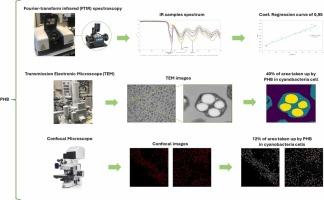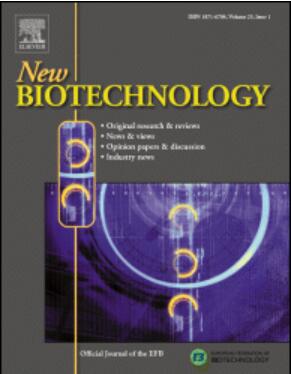蓝藻中的PHB:通过图像处理和FT-IR技术分析生产。
IF 4.9
2区 生物学
Q1 BIOCHEMICAL RESEARCH METHODS
引用次数: 0
摘要
近年来,由于蓝藻能够产生多种有价值的化合物,因此获得了极大的关注。其中一种化合物是聚羟基丁酸酯(PHB),这是一种可生物降解的聚合物,在各种工业应用中具有巨大的潜力。鉴于PHB储存在细胞内,需要一个专门的过程来提取和测量生物聚合物的含量。然而,这一过程非常耗时,而且需要氯仿等对环境有害的化学品。在目前的工作中,我们提出了两种互补的方法来分析和量化蓝藻菌群中PHB的产生。第一个包括应用于透射电子显微镜(TEM)获得的图像的图像处理,可以潜在地应用于其他类型的共聚焦显微镜图像,以进行定性评估。在这种情况下,分割过程允许分化蓝藻细胞内的PHB颗粒。然后通过计算PHB在整个图像和蓝藻细胞中占用的像素面积来建立度量。在PHB含量方面,所有指标的相关性都很好(高于0.65)。第二种方法依靠傅里叶变换红外光谱(FTIR)作为一种无损和快速的方法来分析PHB。在PHB和蓝藻蛋白的单体结构中观察到羰基、酰胺I和酰胺II基团特征引起的吸收峰。线性回归的相关系数r2为0.96。对两种工艺进行了比较,阐述了两种工艺在PHB生产优化中的主要优势。------------------------------------------------------------------------------------------------------------------------.本文章由计算机程序翻译,如有差异,请以英文原文为准。

PHB in cyanobacteria: analyzing production through images processing and FT-IR techniques.
Cyanobacteria have gained significant attention in recent years due to their ability to produce a variety of valuable compounds. One such compound is polyhydroxybutyrate (PHB), a biodegradable polymer with immense potential in various industrial applications. Given that PHB is stored intracellularly, a dedicated process is needed to extract and measure the biopolymer content. Nevertheless, this process is time consuming and requires environmental hazardous chemicals, such as chloroform. In the present work, we present two complementary methods developed to analyze and quantify PHB production in cyanobacteria microbiomes. The first one consists in an image processing applied on images obtained from Transmission Electronic Microscope (TEM), that can potentially be applied to others type of microscope images as confocal, for qualitative assessment. In this case, a segmentation process allows differentiating PHB grains inside cyanobacteria cells. A metric is then established by computing pixels area taken up by PHB in the whole image and in cyanobacteria cells. A good correlation (higher than 0.65) is observed for all indicators as regard to PHB content. The second method relies on Fourier-transform infrared (FTIR) spectroscopy, as a non-destructive and rapid method to analyze PHB. Absorption peaks due to carbonyl, and Amide I and II group characteristics of monomer structure in PHB and cyanobacteria´s protein are observed. A correlation coefficient r2 of 0.96 is reached with the linear regression. A comparison between the two techniques is presented and their main advantages for PHB production optimization are explained.
-------------------------------------------------------------------------------------------------------------------------
求助全文
通过发布文献求助,成功后即可免费获取论文全文。
去求助
来源期刊

New biotechnology
生物-生化研究方法
CiteScore
11.40
自引率
1.90%
发文量
77
审稿时长
1 months
期刊介绍:
New Biotechnology is the official journal of the European Federation of Biotechnology (EFB) and is published bimonthly. It covers both the science of biotechnology and its surrounding political, business and financial milieu. The journal publishes peer-reviewed basic research papers, authoritative reviews, feature articles and opinions in all areas of biotechnology. It reflects the full diversity of current biotechnology science, particularly those advances in research and practice that open opportunities for exploitation of knowledge, commercially or otherwise, together with news, discussion and comment on broader issues of general interest and concern. The outlook is fully international.
The scope of the journal includes the research, industrial and commercial aspects of biotechnology, in areas such as: Healthcare and Pharmaceuticals; Food and Agriculture; Biofuels; Genetic Engineering and Molecular Biology; Genomics and Synthetic Biology; Nanotechnology; Environment and Biodiversity; Biocatalysis; Bioremediation; Process engineering.
 求助内容:
求助内容: 应助结果提醒方式:
应助结果提醒方式:


